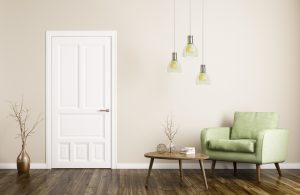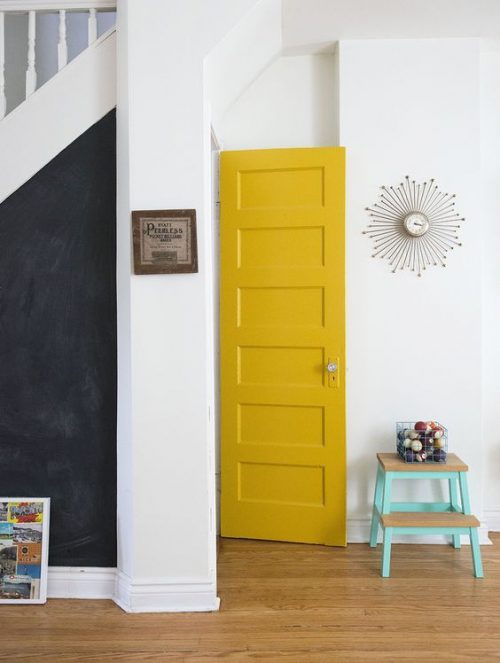Choosing the Right Kind of Doors for Your Home

If you’re in the middle of switching the doors in your home and have checked out the options at a store, the number of choices available has probably overwhelmed you. All of the different kinds of finishes, materials, widths… the options are endless. This makes it immensely difficult to pick out the right kind of door for your home.
Generally speaking, in order to choose your doors you have to think about three things: your budget, the finish and the type of door. According to your budget, you’ll be able to opt for certain types of doors. In our post today, we’ll give you some pointers for choosing the best door within your price range.
Solid interior doors
Solid doors don’t have a hollow core. This makes them the most compact type of door. Depending on the price, solid doors might have a solid wood or chipboard core.
- Doors with solid wood cores. These kinds of doors are wholly from spruce, pine or oak wood. They’re constructed from a thick wood board. This results in a door that is entirely made of the same kind of wood throughout. Solid wood core doors are the strongest and heaviest variety. They’re more expensive because they’re of one piece of high-quality wood.
- Interior doors with chipboard cores. Similar to the previous examples, these doors are also a solid interior door. However, the difference lies in that the high-quality wood– spruce, pine or oak– is only in the outer layer. The door’s core is of cheaper, compressed wood chips. You could say that these are the more economical solid doors. Visually speaking, they look the same but the quality doesn’t compare. And remember, solid interior doors require maintenance.

If you go with this kind of door, remember to take care of it. These doors are 100% natural wood, so you’ll have to remember to treat them as a living being. Be wary of humidity– especially if you use them for a bathroom. Also take care with temperature changes in order to prevent them from morphing. If you take good care of them, these doors can last a life-time.
Hollow interior doors
Let’s move on to the more economical kind of door: hollow doors. These are doors that are partially hollow on the inside. On the outside, they look like a normal door but on the inside, these doors have a honeycomb-like structure. The structure is made from cardboard, making the door very light– around 20 kg.
One of the main downsides of these doors is that they’re not very good for insulating sound nor heat. You’ll have to really analyze if the room’s heat loss in the winter, and all the sounds that pass through the door are worth the price. If you’re looking for a new door between the living room and hallway that’ll always be kept open, for example, there’s no need to pay for something that costs more than a hollow door.

So, which door is right for you?
After reading our post, we’re sure that you have a better idea on certain things regarding doors; or at least have discarded some options. As you’ve read, the main factor to keep in mind is the amount that you’re willing to spend on doors, or the budget that you have at your disposal. Based on our budget, you can start your first round of elimination.
It’s no secret that solid oak wood doors are the best quality for interior doors. The biggest downside is that a door that’s completely solid normally costs three or four times more than a hollow door. That, multiplied by the number of doors that you want to buy, equates to a big bill.
We’re not saying don’t go for hollow doors. But they’re perfect examples that illustrate that cheap things are expensive. They don’t last long, have poor insulation and they can break if we use too much force.
With those things in mind, we lean towards interior solid doors that use chipboard cores. We think that they’re the best option because they’re right in the middle of hollow and completely solid doors. They’re good insulators, for both temperature and humidity, and you can find them at a good price. In addition, you can choose the type of wood that’s on the door’s exterior layer, meaning that you’ll be able to match it perfectly with your home decor.
If you’re in the middle of switching the doors in your home and have checked out the options at a store, the number of choices available has probably overwhelmed you. All of the different kinds of finishes, materials, widths… the options are endless. This makes it immensely difficult to pick out the right kind of door for your home.
Generally speaking, in order to choose your doors you have to think about three things: your budget, the finish and the type of door. According to your budget, you’ll be able to opt for certain types of doors. In our post today, we’ll give you some pointers for choosing the best door within your price range.
Solid interior doors
Solid doors don’t have a hollow core. This makes them the most compact type of door. Depending on the price, solid doors might have a solid wood or chipboard core.
- Doors with solid wood cores. These kinds of doors are wholly from spruce, pine or oak wood. They’re constructed from a thick wood board. This results in a door that is entirely made of the same kind of wood throughout. Solid wood core doors are the strongest and heaviest variety. They’re more expensive because they’re of one piece of high-quality wood.
- Interior doors with chipboard cores. Similar to the previous examples, these doors are also a solid interior door. However, the difference lies in that the high-quality wood– spruce, pine or oak– is only in the outer layer. The door’s core is of cheaper, compressed wood chips. You could say that these are the more economical solid doors. Visually speaking, they look the same but the quality doesn’t compare. And remember, solid interior doors require maintenance.

If you go with this kind of door, remember to take care of it. These doors are 100% natural wood, so you’ll have to remember to treat them as a living being. Be wary of humidity– especially if you use them for a bathroom. Also take care with temperature changes in order to prevent them from morphing. If you take good care of them, these doors can last a life-time.
Hollow interior doors
Let’s move on to the more economical kind of door: hollow doors. These are doors that are partially hollow on the inside. On the outside, they look like a normal door but on the inside, these doors have a honeycomb-like structure. The structure is made from cardboard, making the door very light– around 20 kg.
One of the main downsides of these doors is that they’re not very good for insulating sound nor heat. You’ll have to really analyze if the room’s heat loss in the winter, and all the sounds that pass through the door are worth the price. If you’re looking for a new door between the living room and hallway that’ll always be kept open, for example, there’s no need to pay for something that costs more than a hollow door.

So, which door is right for you?
After reading our post, we’re sure that you have a better idea on certain things regarding doors; or at least have discarded some options. As you’ve read, the main factor to keep in mind is the amount that you’re willing to spend on doors, or the budget that you have at your disposal. Based on our budget, you can start your first round of elimination.
It’s no secret that solid oak wood doors are the best quality for interior doors. The biggest downside is that a door that’s completely solid normally costs three or four times more than a hollow door. That, multiplied by the number of doors that you want to buy, equates to a big bill.
We’re not saying don’t go for hollow doors. But they’re perfect examples that illustrate that cheap things are expensive. They don’t last long, have poor insulation and they can break if we use too much force.
With those things in mind, we lean towards interior solid doors that use chipboard cores. We think that they’re the best option because they’re right in the middle of hollow and completely solid doors. They’re good insulators, for both temperature and humidity, and you can find them at a good price. In addition, you can choose the type of wood that’s on the door’s exterior layer, meaning that you’ll be able to match it perfectly with your home decor.







